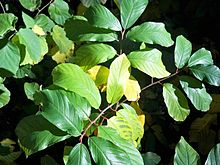- Magnesium deficiency (agriculture)
-
This article is about magnesium deficiency in plants. For the same nutritional deficiency in humans (ICD10 code E61.2), see magnesium deficiency (medicine). For a general article on magnesium functions in living organisms, including plants, see magnesium in biology.
Magnesium (Mg) deficiency is a detrimental plant disorder that occurs most often in strongly acidic, light, sandy soils, where magnesium can be easily leached away. Magnesium is an essential macronutrient found from 0.2-0.4% dry matter and is necessary for normal plant growth.[1]
Excess potassium, generally due to fertilizers, further aggravates the stress from the magnesium deficiency.[2]
Magnesium has an important role in photosynthesis because it forms the central atom of chlorophyll.[1] Therefore, without sufficient amounts of magnesium, plants begin to degrade the chlorophyll in the old leaves. This causes the main symptom of magnesium deficiency, chlorosis, or yellowing between leaf veins, which stay green, giving the leaves a marbled appearance. Due to magnesium’s mobile nature, the plant will first break down chlorophyll in older leaves and transport the Mg to younger leaves which have greater photosynthetic needs. Therefore, the first sign of magnesium deficiency is the chlorosis of old leaves which progresses to the young leaves as the deficiency continues.[3] Magnesium also is a necessary activator for many critical enzymes, including ribulosbiphosphate carboxylase (RuBisCO) and phosphoenolpyruvate carboxylase (PEP), both essential enzymes in carbon fixation. Thus low amounts of Mg lead to a decrease in photosynthetic and enzymatic activity within the plants. Magnesium is also crucial in stabilizing ribosome structures, hence, a lack of magnesium causes depolymerization of ribosomes leading to pre-mature aging of the plant.[1] After prolonged magnesium deficiency, necrosis and dropping of older leaves occurs. Plants deficient in magnesium also produce smaller, woodier fruits.
Magnesium deficiency may be confused with zinc or chlorine deficiencies, viruses, or natural aging since all have similar symptoms. Adding Epsom salts (diluted to 8.5 oz. per 2.2 gal. of water) or crushed dolomitic limestone to the soil can rectify magnesium deficiencies. For a more organic solution, applying home-made compost mulch can prevent leaching during excessive rainfall and provide plants with sufficient amounts of nutrients, including magnesium.[4]
References
- ^ a b c Norman P.A. Huner; William Hopkins. Introduction to Plant Physiology 4th Edition. John Wiley & Sons, Inc.. ISBN 978-0-470-24766-2.
- ^ Ding Y.; Chang C.; Luo W.. "High Potassium Aggravates the Oxidative Stress Induced by Magnesium Deficiency in Rice Leaves". Pedosphere 18 (3): pp. 316-327.
- ^ Hermans C.; Vuylsteke F.; Coppens F.. "Systems Analysis of the responses to long-term magnesium deficiency and restoration in Arabidopsis thaliana". New Phytologist 187: pp. 132-144.
- ^ "Problem Solving: Magnesium Deficiency". http://www.gardenersworld.com/how-to/problem-solving/magnesium-deficiency/.
Categories:- Physiology
- Plant physiology
- Magnesium
- Biology and pharmacology of chemical elements
Wikimedia Foundation. 2010.

